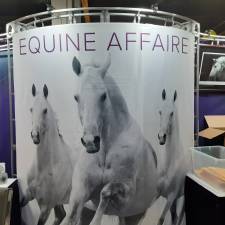
by Marion E. Altieri for Equine Info Exchange
The Nederlander Theatre in Times Square sets the stage for a glimmering, elegant romp through the lives, challenges and rivalrous relationship of the paint-and-powder world of two of America’s most dynamic businesswomen. Before post-modern cool and neon-colored eye shadows replaced the quest for actual beauty—Helena Rubinstein and Elizabeth Arden were taking on the men in the American cosmetics’ industry, and winning. They literally painted the town, red.
Fighting tooth-and-nail against both each other and, simultaneously against an establishment that dictated that men knew more about women’s needs and women’s beauty than did women, themselves—Rubinstein and Arden refused to go away, refused to lose, refused to concede.
War Paint, the hot new musical about the dynamic dua, stars Patti LuPone as Rubinstein and Christine Ebersol as Arden. Both Lupone and Ebsersol have been nominated for a Tony Award for Best Leading Actress in a Musical. The timeliness of this production is quite obvious: at this point in time, western culture has become more about glitz than about bringing out underlying beauty. Visually-loud and obnoxious, party-girl make-up and colors are slapped on—effects that rival Times Square’s own visual cacophony.
It’s about time that big-shouldered women from this era were recognized and celebrated—but none is more deserving than horse racing’s own Elizabeth Arden.
She was born Florence Nightingale Graham in Woodbridge, Ontario, Canada in 1878, the daughter of immigrants from the United Kingdom. She fell in love with horses as a little girl, and took that love with her all the way from Ontario to Manhattan, where she went to work with her brother at the Squibb Pharmaceuticals Company. At Squibb, she worked as a bookkeeper, but found her way into their labs, where she could learn about skincare. Her new-found passion and savvy would end up making her a fortune—and establishing her as one of the uber, genuinely feminine forces of nature of whom War Paint sings (and dances).
Florence Nightingale Graham became known professionally as Elizabeth Arden, and the rest, they say—is history. But as Arden, herself, would tell you: like any great skin peel—there’s so-much more beneath the surface.

As happens with every human heart who is conquered early by horses, Arden could not stay away from her beloveds for long. The wealth she amassed with Elizabeth Arden (the company) gave her the cash to indulge herself in buying Thoroughbred race horses. And creating a farm, Maine Chance Farm in Lexington, Kentucky—which was named for her Maine Chance spa in New England.
For racing purposes, she became known as Elizabeth N. Graham, a derivative of her birth name. Her first stable was named Mr. Nightingale(s). (Most race fans had no idea when they saw those names in the program that the horses were owned by a [female] dynamo of the cosmetics industry!)
By the 1940s, Arden was one of the most prominent names in horse racing: in 1945 alone, her Thoroughbreds had won more than $500,000. (> $6,770,000 in 2017.)
Her savvy as a race horse owner got her onto the cover of Time: as her visage graced the cover of the magazine in 1946, the title rang out, “A queen rules the Sport of Kings.”

Eight Hour Cream: the Formula of Champions
Arden’s first product was her wildly-popular—and still popular today—Eight Hour Cream, which she conjured in the early 1930s. She created the balm (the core ingredients of which are petrolatum, beta-hydroxy and Vitamin E)—to soothe, heal and relax stressed skin cells. The balm contains no stem cells or other “new and improved” chemicals that are touted by other companies’ facial creams. And why should it change? In the 80+ years since its creation, Elizabeth Arden Eight Hour Cream has proven itself over-and-over again, to millions of women—and men—on this planet.
Even Prince Harry of the U.K. is a fan; he reports that he’s taken it on his expeditions to the North Pole. As its creator intended, it soothes, heals and relaxes stressed skin cells—so why would Arden’s company mess with a formula that needs no improvement?
Arden believed so strongly in the curative properties of her Eight Hour Cream that she insisted that her trainers use it on all her horses. Cuts, bruises, bucked shins—you name it, if it was a skin or hair situation—Eight Hour Cream was applied. Legs, hooves, faces—all received spa treatments on a regular basis, along with the other benefits of being horses who were, To the Manor Born.
Arden reported gleefully, “Try it! I use it on my horses!”—and she did.
Her Horses, Her Children
And she would not have used just anything on her precious horses, for to Arden—her horses were her babies.
Saratoga’s beloved Mrs. Marylou Whitney, a friend of Arden, noted once that Arden’s horses indeed were “like her children,” and that “…she even carried pictures of them in her billfold.”
She purchased her first Thoroughbred for $1,000 (>$17,800 now). Her conquests must have been heady, for a girl from Ontario who just loved horses. From there, she went on to breed and race big horses, including:
Jet Pilot, who won the 1947 Kentucky Derby
Ace Admiral, victor of the 1948 Travers
Fascinator, winner of the 1954 Kentucky Oaks
and Gun Bow, Future Hall of Famer.
These Champions—and all 250 of her equid treasures—were treated with kid gloves, and such were the instructions to trainers, exercise riders, jockeys and grooms: And the aforementioned professionals who worked with her horses were no slackers: Tom Smith, who’d taken Seabiscuit from being a beaten-up, throwaway horse to being, well, Seabiscuit—was among the trainers in her stable who knew that Arden meant it when she said that nothing was too good for her horses:
- Music was played in the barns, to soothe the horses’ spirits.
- The barns were screened, to ward off flies.
- She massaged their legs herself, if a horse had a limp.
- She fired a groom, whose “mean face” might upset her horses.
- Whips were forbidden, by jockeys during races and by exercise riders during workouts. NO whips allowed. Period.
- Horses coming off the track were wrapped in cashmere blankets.
- Clover from her Maine farm was shipped regularly to Kentucky, to supplement the horses’ diets and give them a tasty treat.
Surely, Mrs. Whitney’s observation was on-target; if only all horse owners shared Arden’s ardent affection for her beautiful equid babies.

No Exceptions for Moguls
We would be remiss if we failed to mention that, even the well-heeled and wealthy in horse racing aren’t exempt from tragedy and pain. In 1946, an unquenchable fire at Chicago racetrack took the lives of 22 of Arden’s beloved horses. (Jet Pilot and a few others had been shipped back to Kentucky just prior to the devastation.) This was not her first Grief Rodeo, for she’d lost three of her show horses in a fire at Belmont Park in 1937. The loss of another 22, nine years later, seems to be almost unimaginable, for a woman whose heart and soul were wrapped up in her equine children.
But she was a real horsewoman, from deep within: suffering the wrenching loss of so many of her equine treasures must have torn her heart to shreds. But she carried on, even using her Eight Hour Cream on her Belmont horses who were injured in the 1937 fire. (Apparently she sent over gallons of the cream.)
Like the nursing heroine for whom she was named prophetically, she stiffened her back and her resolve, and kept moving forward—healing and loving with all she had.
Fingers are Not Carrots
That inner strength came in handy when dealing with horses, for of course, every horse has his or her own quirks that must be accommodated, dodged or avoided from time-to-time. A seasoned horsewoman must be unflappable and unfazed by the actions of unpredictable horses. One day in 1959, Jewel’s Reward adamantly did not want to be petted at Santa Anita. He demonstrated this preference emphatically, when he took a bite out of Arden’s right index finger. But his owner seemingly didn’t blink for long: she took such things as a missing digit-tip with grace, getting the tip of her finger sewed back on at a local hospital, then returning home to New York.
(She had such confidence in her Eight Hour Cream, that it’s safe to wager that she used it liberally during the finger-healing process, with some custom vet wrap for stability.)
Arden: Business Genius, Horse Lover, Role Model
To make it in “a man’s world”—whether that world is the cosmetics industry in the 1930s or horse racing (in any era)—it takes more. A woman must bring more to the table than a good idea and a friendly smile. She must bring more than rouge to create a cosmetics company; more than love and desire to successfully breed and race horses in America. Both these industries require talent, brilliance, planning and the ability to stand up for yourself—all the while, keeping your priorities straight, and always looking out for the best for those whom you love.
The late, great Elizabeth Arden had all of those traits, in spades. On Broadway, she’s portrayed as being a big-shouldered Broad—a strong, tough, formidable force. And, that she was. But she was also the tender-hearted Mother to 150 horses whose welfare came first and foremost. Whose Eight Hour Cream soothed cuts and bucked shins, even as she no-doubt told each of them how much she loved them, and hugged their necks with both arms (and 9.75 fingers).
Horse racing needs more women like Elizabeth Arden. Business is business, but horse business…is love.












